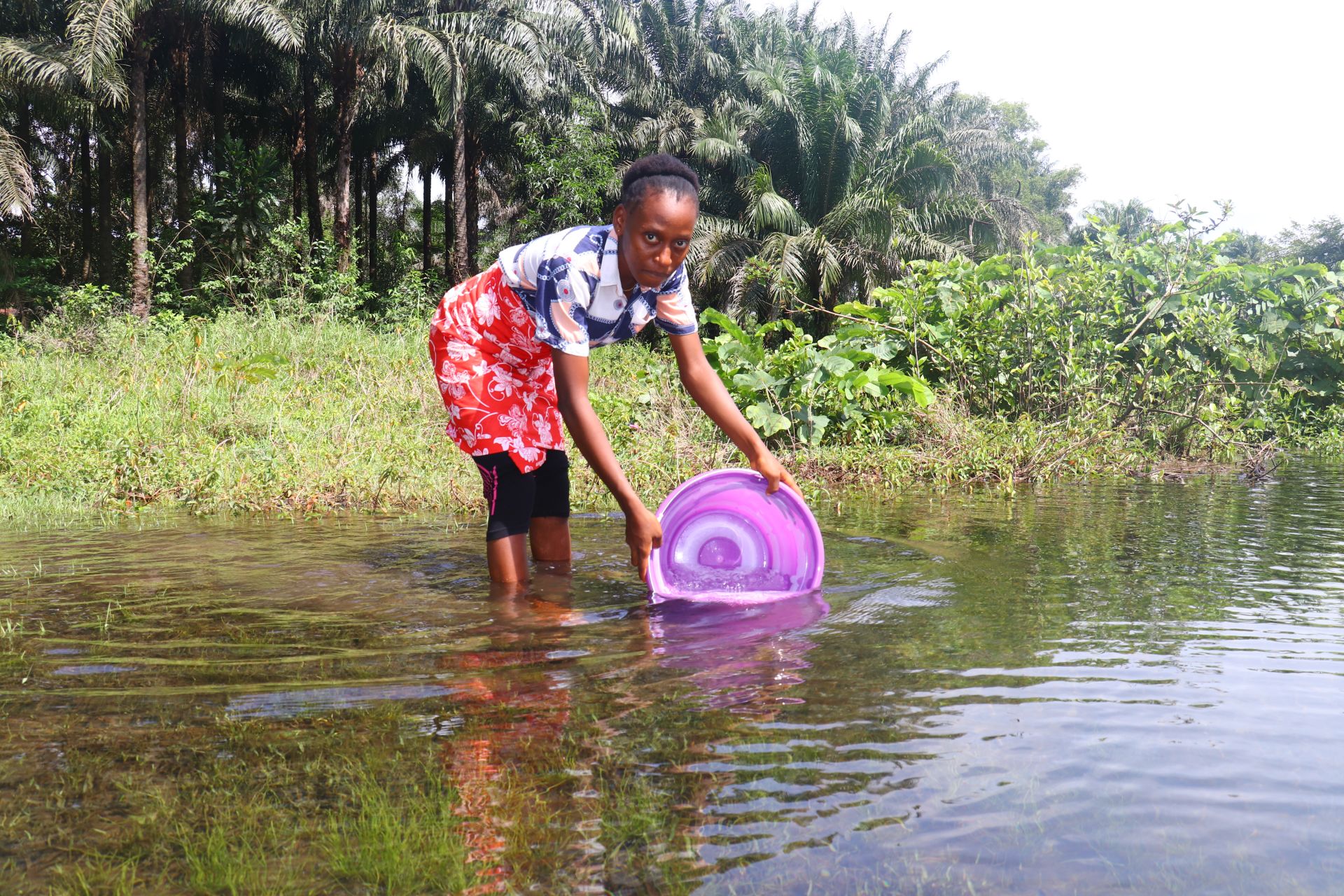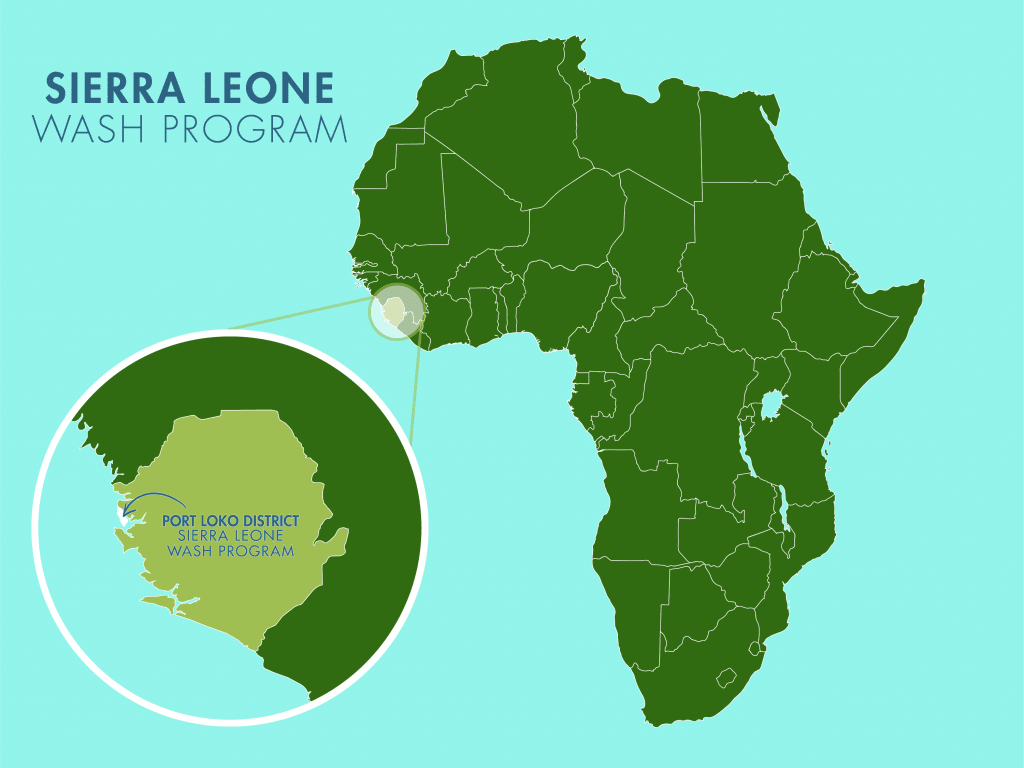The Misra Community, home to 205 residents, faces daily challenges in accessing clean and reliable water. The community depends on two main sources — surface water and a dug well — both of which are affected by seasonal shortages and contamination. For young people like seventeen-year-old Aminata, fetching water is a tiring and time-consuming part of daily life that impacts every aspect of her education and wellbeing.

Aminata collects water from the river.
Aminata described her struggle clearly: “The current water source is serving [a] lot of people in the community, and that serves as a key reason there is not enough water at the source. During the dry season, the water source also dries due to the decrease of the water table at the source. As a result of that, I always feel unhappy because the water cannot serve the entire village when we need it the most. I feel unhappy because it prevents me from doing my day activities on time today.”
The long distances and harsh terrain make fetching water particularly exhausting for Aminata and others her age. The community’s main water source is located far from most homes, requiring a long and arduous walk across rocky terrain.

Aminata hauls water home.
She explained the impact this has on her education and daily life: “My time at school is negatively affected when there is a lack of water in the community. I am unable to go to school on time, and I am always late to school due to the unavailability of water within the community. The lack of water prevents me from reading my school notes at home, and affects me at the end of the academic year with low exam grades. Therefore, the lack of water in the community impacted my time at school.”
When asked what she would do if she didn’t have to spend so much of her day fetching water, Aminata responded thoughtfully: “As a school-going pupil, I will focus on my academic activities if getting water doesn't take long. For instance, I will be able to go to school on time, work on my assignments, and have enough time to study at home when I get off from school. There are also other household chores that I will be able to help my parents with, so they will be able to complete [them] on time and focus on other things.”

Aminata helps out at home, washing dishes.
Safety is a significant concern for Aminata and other community members. She shared, “I am worried about the safety of the current water source because it is not safe for drinking purposes. It is open to all domestic and wild animals that may contaminate the water. The source is out of the community, and there are agricultural activities that are going on around the source that will contaminate the water through the application of fertilizer.”
Aminata believes that a new waterpoint within the community would make a huge difference in her life. “I will be safer if a new waterpoint is constructed in this community. I will have access to safe and pure drinking water at any time of the day. If new water is built within the community, I will no longer go to the swamp to fetch water. The long walk to the current water [source] will be over if a new waterpoint is constructed in this community.”

Despite the hardships she faces, Aminata remains hopeful about her future. “My plan for the future is to be a teacher,” she said with determination.
However, the burden of fetching water continues to weigh heavily on her. “I am always unhappy when I am sent to fetch water. This is because the water source is far from the community, and a water user will always become tired after fetching water from that source.”
Aminata’s story reflects the struggles of many young people in Misra Community — the long walks, unsafe conditions, and loss of valuable time for study and rest. A new, safe water point would not only ease these daily hardships but also open the door for brighter futures, helping students like Aminata focus on education and achieve their dreams.
Steps Toward a Solution
Our technical experts worked with the local community to identify the most effective solution to their water crisis. They decided to rehabilitate an unsafe, insufficient well to convert it to a borehole well.
Rehabilitating a Well
Abundant water often lies just beneath our feet. Aquifers—natural underground rivers—flow through layers of sediment and rock, offering a constant supply of safe water.
The well marked for this overhaul is dry for several months a year and needs major work to supply adequate, clean water to the community year-round. A hand auger will be lowered inside the well, powered by a drill team. The team will work to drill several meters deeper to hit a sufficient water column to ensure the well supplies water throughout all seasons. As the team drills, the casing will be installed, transforming the bottom of this well into a borehole. PVC piping will connect this lower system directly to the pump, a component we know will also improve water quality. Finally, we will reconstruct the platform for the well and attach the hand pump.
Once this plan is implemented, everyone within the community will have access to safe drinking water in quality and quantity, even through the dry months.
Community Education & Ownership
Hygiene and sanitation training are integral to our water projects. Training is tailored to each community's specific needs and includes key topics such as proper water handling, improved hygiene practices, disease transmission prevention, and care of the new water point. Safe water and improved hygiene habits foster a healthier future for everyone in the community.
Encouraged and supported by our team's guidance, the community elects a water user committee representative of its diverse members. This committee assumes responsibility for maintaining the water point, organizing community efforts, and gathering fees to ensure its upkeep.

 Borehole Well and Hand Pump
Borehole Well and Hand Pump

















